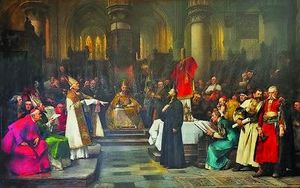Dan Brown’s ‘historical’ novel The Da Vinci Code was published in 2003 and has topped the best-seller lists ever since. A year after its publication, it had sold almost six million hardback copies. The movie is on the way, directed by Ron Howard.
The book is a gripping murder mystery, with an extraordinary number of events compressed into little more than 24 hours. As a thriller, it succeeds at one level, with each of the 105 chapters (followed by an epilogue) ending in such a way that the reader feels compelled to read on.
With suspense, conspiracies and a touch of romance (albeit more Gnostic than physical!) it is a real page-turner. Having said that, the plot is clever but contrived, the story line is far-fetched, and the ending is particularly lame.
Animated by paranoia
The message of the novel is that, in the words of the fictional Sir Leigh Teabing: ‘almost everything our fathers taught us about Christ is false’ (p.235). Or, ‘every faith in the world is based on fabrication’; ‘Those who truly understand their faith understand the stories are metaphorical’ (‘Robert Langdon’, pp. 341-342).
The reader is meant to be swept along with the belief that the Bible was a male plot against women, and the real Jesus was a feminist before his time. ‘Real Christianity’ is not what William Wilberforce thought it was – Evangelicalism – but a mixture of goddess worship with what Brown thinks is Gnosticism.
Animated by paranoia and armed with a conspiratorial view of history, Dan Brown draws his readers into the ‘real’ facts – that Jesus had sexual relations with Mary Magdalene; that the Bible as we know it was put together in the days of the emperor Constantine (who died in A. D. 337); and that in 325 the Council of Nicaea voted that Jesus was divine – a kind of ecclesiastical promotion. And all this was done to serve the interests of male bishops.
Mary Magdalene herself is supposed to be the Holy Grail – a secret guarded by the ‘Priory of Sion’.
If any of this were true it would justify the sarcasm of liberal theologian John Dominic Crossan, who cited as an ancient and venerable principle of biblical exegesis the idea that ‘if it looks like a duck, walks like a duck, and quacks like a duck, it must be a camel in disguise’.
Voting for the deity of Christ?
Sir Leigh Teabing, who appears initially as the eccentric English historian of the Holy Grail, makes a most unhistorical claim concerning the Council of Nicaea (A. D. 325): ‘until that moment in history, Jesus was viewed by his followers as a mortal prophet … a great and powerful man, but a man nevertheless. A mortal’.
Sophie Neveu’s breathless response is: ‘Hold on. You’re saying Jesus’ divinity was the result of a vote?’ Undeterred, Teabing pontificates, ‘A relatively close vote at that’ (p.233). He even adds that the Dead Sea Scrolls and the Nag Hammadi texts reveal a human Jesus.
The reader is meant to understand that Sophie Neveu has just been initiated into what her name implies: ‘new wisdom’. As we shall see, the adjective is more appropriate than the noun.
Arius on trial
How do we unpack all this? What is history and what is fiction? The short answer is that it is almost entirely fiction. It is true that there was a Council of Nicaea in 325. After that, Teabing gets nothing right.
The council was called because a presbyter named Arius, from Alex-andria in Egypt, came to the view that Christ was the first created being. About the year 318, Arius was busy preaching that God created Christ, then the Holy Spirit, and finally the world.
Like the modern-day Jehovah’s Witnesses, Arius viewed Christ as the highest of the angels, not the divine Word made flesh. Whatever Arius’ deficiencies as a theologian, he certainly did not teach that Jesus was simply a mortal prophet. Neither side in the debate believed anything remotely as low-key as that.
Nor was the vote a close one. We are not sure how many bishops were at Nicaea as no minutes have survived. Eusebius thought there were 250 bishops but Sozomen put the figure at 300.
How many supported Arius? Sozomen writes that 17 supported Arius at the opening of the council, but only five bishops refused to sign the creed and/or the attached anti-Arian anathemas. It seems that Teabing’s mathematical skills match his expertise in history.
Dualistic view of life
What about the Dead Sea Scrolls, discovered in 1947 (not the 1950s, p.234)? They predate the New Testament and, not surprisingly, they simply do not mention Jesus. Their ‘Teacher of Righteousness’ is not John the Baptist, and Jesus is not their ‘Wicked Priest’.
The Gnostic Nag Hammadi texts are different, however. They come from the second century and later, and are full of references to Christ. Gnosticism is a dualistic view of life, where spirit is seen as divine, and matter (flesh) as evil.
This means that the Gnostics rejected the incarnation. In the Gnostic scheme of things Christ is a divine spirit, not God made man. The Gnostic ‘Christ’, like Teabing’s, is a long way from the Christ of the Gospels, but for different reasons.
A multitude of manuscripts
Teabing claims that the Bible is a work of man: ‘The Bible did not arrive by fax from heaven … it has evolved through countless translations, additions and revisions’ (p.231). He asserts that there were over 80 Gospels, but that Constantine ordered a ‘new Bible’ and had all the earlier Gospels burnt. He also refers to a ‘legendary Q document’ (p.256).
In reply, a number of points need to be made:
1. The Bible has not ‘evolved through translations’. Translations usually go back to the early Hebrew and Greek texts. No translator worthy of his salt would make a translation of a translation.
2. There is genuine debate among Bible scholars over a small number of verses, but not a single Christian doctrine is affected by this debate. All the major Christian doctrines – such as the incarnation and resurrection of Christ – are taught in many places in Scripture.
3. There are over 5,000 Greek manuscripts of the New Testament and 8,000 or so incomplete manuscripts. To these can be added Scripture quotations by the early Church Fathers and early translations into languages other than Greek. That is a huge number of manuscripts.
No other piece of ancient literature comes anywhere near that. Homer’s Iliad has 643 copies – still a long way short of the New Testament – while Caesar’s Gallic Wars with only 9 or 10 good manuscripts is far more typical. Yet no one questions the accuracy and authenticity of these ancient works.
The New Testament translator has more manuscripts to deal with than he can reasonably handle.
How many Gospels?
4. There were only ever four Gospels. In his work Against Heresies,Irenaeus of Lyons – who wrote around A. D. 180 – contributed to the emerging pattern of orthodoxy. He asserted that there were only four Gospels because there were only four world zones, four winds, and four faces on the cherubim.
His reasoning is spurious but that is of no consequence. The important thing is that he risked no contradiction in asserting that there were only ever four authentic and authoritative Gospels. This was universally accepted long before Constantine was even born.
5. ‘Q’ is a hypothetical document supposedly containing material common to Matthew and Luke but not to Mark. Whether or not it ever existed is of almost no consequence to biblical criticism. One may accept or dismiss the existence of Q and still hold to the full authority of Scripture – and vice versa.
Next month we shall examine the sources – the Gnostic Gospels – on which Brown relies.












